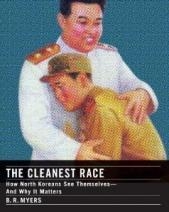In a satellite image of the Korean peninsula at night, the South and its neighboring countries are ablaze in lit civilization, while the entire North is shrouded in darkness—with the exception of a single pinprick. The lone star punctuates the capital city of Pyongyang, home to the luminary Kim Jung Il. The image is simultaneously harrowing and fascinating in what it reflects: that Kim Jong Il is, to the North Korean masses, the single beacon of hope for the nation, their existence. Or is it an asterisk, a cue to an appended truth, perhaps, that exists beyond what meets the Western eye?

The Cleanest Race: How North Koreans See Themselves—And Why It Matters
By B.R. Myers
Melville House
The symbolic photograph lends itself to the discussion of North Korean ideology that B.R. Myers explores in The Cleanest Race: How North Koreans See Themselves—and Why It Matters. In this fresh, compelling analysis of the psychology behind the regime, Myers claims that the West’s understanding of the country is misguided, for North Korea’s dominant ideology is not Communist, Stalinist, or even a Confucian patriarchy. Instead, the real ideology is founded on a belief of unique moral superiority of the Korean race—a belief so entrenched that the mass support for Kim Jong Il and his father is, for the most part, uncoerced. According to Myers, this conviction is the key to understanding why the regime cannot be pressured into giving up its nuclear program.
An American-born professor of North Korean studies at Dongseo University and a contributing editor to The Atlantic, Myers not only makes fascinating and provocative claims, but does so in light of domestic North Korean propaganda—which is what makes his book stand out from others in the genre. Referring to specific novels, short stories, films, television dramas, comics, and paintings, all of which he spent nearly eight years studying, Myers interprets the country’s inaccessible culture through the lens of its "arts." Kim Il Sung’s "hermaphroditic" image as "the loving parent who holds and nurtures all Korean children at his breast…exert[s] a far more emotional attraction than any of the unambiguously paternal leaders of Eastern Europe," Myers writes. He notes the recurrence of extreme racial nationalism, anti-Americanism, and praise for the state’s leader in maternal—not paternal—metaphors. This is important, Myers insists, because "the absence of a patriarchal authority figure may have helped the regime preserve stability by depriving its people of a target to rebel against."
From the excerpts of song lyrics and novels to the illustrations (even a glossy, colorful inset of annotated paintings and posters) that adorn every other page, we literally "see" unexplored sides of the so-called Hermit Kingdom. But it is also interesting to discover how a culture typically painted in the starkest light seems to make art relevant on the most pragmatic level. As militant as the nation is, art—albeit government-sanctioned art—is the driving force of the masses. Subscribing to the belief that "it is seldom what is that is of political importance, but what people think is," North Korea relies on its "arts" to construct and maintain its self-image as the "purest race." Ideology is taught through fictional stories about the leader, and it is through this crafty medium that the state gets its fundamental message of ethnic virtues across.
What may come as a surprise is that not every narrative is explicitly political. Despite the country’s focus on the armed forces, popular protagonists are "blushing, virginal girls" whose every act of kindness is "meant to demonstrate the unique goodness of the race," as "[females] are more natural symbols of chastity and purity and thus of Koreanness." There is a palpable lack of conflict in narratives, for even when stories call for a fall from grace, North Koreans are never depicted as the fallen. If storytellers want to criticize subversive activity, they must resort to animal figures. "A warning against fleeing to China, for example, is expressed as a tale of a squirrel who ventures too far abroad."
While Myers’s focus on the racial element of North Korean ideology seems at times to be a reach, he certainly probes the hard questions—ones to which many experts of North Korea don’t typically devote their attentions—and he does so with a consciousness afforded him by his linguistic and cultural fluency. What do North Koreans view as their destiny? What is the logic behind their personality cult? With propaganda as the looking glass, Myers even succeeds in explaining how the regime has maintained its power despite its inconsistencies in governance, and how it manages to convince its people that the food shipments from the U.S. are actually reparations for past "Yankee" crimes.
We have glimpsed the mysterious country ad nauseum in terms of its sterile, gray monuments and mass games, but Myers's unique analysis sheds light into the deepest crevices of North Korean ideology by illuminating the core. On satellite, our end of the map may blaze, but it seems that as outsiders, we, too, have been kept in darkness—a startling fact that also lingers beyond the lit asterisk.


